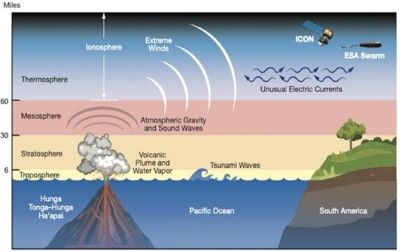Context
The eruption of the underwater volcano Hunga Tonga-Hunga Ha’apai (Hunga Tonga for short) in 2022 had profound and unexpected impacts on global weather patterns. This event, which took place on January 15, 2022, in the Pacific Kingdom of Tonga, not only generated a massive tsunami and sent sound waves around the world multiple times, but also introduced unprecedented amounts of water vapor into the stratosphere. A new study published in the Journal of Climate examines the long-term climatic consequences of this eruption, revealing its potential to alter weather patterns for years to come.
The Unique Nature of Hunga Tonga's Eruption
Typically, volcanic eruptions release large amounts of sulfur dioxide into the atmosphere. This gas transforms into sulfate aerosols, which reflect sunlight away from the Earth, leading to temporary cooling of the planet's surface. However, the Hunga Tonga eruption deviated from this norm due to its underwater nature. Instead of emitting significant amounts of sulfur dioxide, it released an extraordinary quantity of water vapor – around 100-150 million tonnes, equivalent to the volume of 60,000 Olympic swimming pools. The intense heat of the eruption vaporized seawater, propelling it high into the stratosphere, a region between 15 and 40 kilometers above the Earth where it neither forms clouds nor rain due to its dryness.
In the stratosphere, water vapor acts as a potent greenhouse gas and facilitates chemical reactions that deplete the ozone layer. The sheer volume of water vapor from Hunga Tonga's eruption created a scenario without precedent in the recorded history of volcanic activity. Since satellite measurements of stratospheric water vapor have only been possible since 1979, scientists lacked comparative data to predict the outcomes accurately.
Initial Observations and Uncertainty
From the moment of the eruption, experts in stratospheric science worldwide began analyzing satellite data to understand the potential impacts. While some focused on the traditional effects of volcanic eruptions, such as sulfate aerosol production, others investigated the unprecedented injection of water vapor and its implications. The critical questions they sought to answer included the duration water vapor would remain in the stratosphere, its distribution, and its broader climatic effects.
Given the novel nature of the eruption, direct measurements alone could not provide definitive answers. Thus, researchers turned to climate models to simulate the potential future scenarios. They conducted two simulations using the same climate model: one assuming no volcanic eruption occurred and another incorporating the 60,000 Olympic swimming pools worth of water vapor into the stratosphere. By comparing these simulations, researchers could isolate the effects attributable to the water vapor.
Findings on the Ozone Layer
One significant finding from the study was the connection between the Hunga Tonga eruption and the unusually large ozone hole observed from August to December 2023. The simulations, which predicted this event almost two years in advance, indicated that the water vapor facilitated chemical reactions that contributed to the depletion of the ozone layer. However, this influence was predicted to be a one-time occurrence, as the water vapor had by then sufficiently reached the polar stratosphere over Antarctica. In subsequent years, the diminishing water vapor concentration would no longer significantly impact the ozone hole.
Impact on Global Weather Patterns
While the overall impact of the Hunga Tonga eruption on global mean temperatures was found to be minimal, around 0.015 degrees Celsius, the eruption had more pronounced regional effects. The study highlighted that this minimal temperature increase means the recent record-high temperatures cannot be attributed to the eruption.
Nevertheless, the eruption did have surprising and lasting impacts on specific regions. For instance, the model predicted that the northern half of Australia would experience colder and wetter winters until about 2029. In contrast, North America would face warmer winters, while Scandinavia would see colder winters. These changes are attributed to alterations in atmospheric wave patterns caused by the introduction of water vapor into the stratosphere. These waves play a crucial role in shaping highs and lows, which in turn directly influence weather patterns.
Broader Implications and Future Research
The findings from this study underscore the complexity and interconnectedness of atmospheric processes. The introduction of a substantial volume of water vapor into the stratosphere by an underwater volcanic eruption presents a unique case study with far-reaching implications. It highlights the need for further research to fully understand the long-term impacts of such events on global weather and climate.
The study’s authors acknowledge that their climate model is just one approach to investigating the effects of the Hunga Tonga eruption. They emphasize the importance of continued scientific inquiry to either confirm or challenge their findings. Additionally, the study did not account for other influential factors such as the El Niño–La Niña cycle, suggesting that future research should incorporate these elements for a more comprehensive understanding.
Conclusion
The Hunga Tonga eruption of 2022 stands out not only for its immediate dramatic effects but also for its long-term influence on global weather patterns. The unprecedented injection of water vapor into the stratosphere by this underwater volcano has set in motion a series of climatic changes that are only beginning to be understood. The research published in the Journal of Climate offers crucial insights into these impacts, predicting significant regional weather variations for years to come. As the scientific community continues to study this unique event, it will enhance our understanding of how such extraordinary natural phenomena can shape the Earth's climate.
|
Probable Questions for UPSC Mains Exam 1. Discuss the unique nature of the Hunga Tonga-Hunga Ha’apai volcanic eruption of 2022 and its unprecedented impact on global weather patterns. How does the injection of water vapor into the stratosphere differ from the usual volcanic emissions?(10 marks, 150 words) 2. Evaluate the long-term regional climatic effects predicted as a result of the Hunga Tonga eruption. What are the implications of these changes for climate models and future research in atmospheric science?(15 marks, 250 words) |
Source - The Hindu







